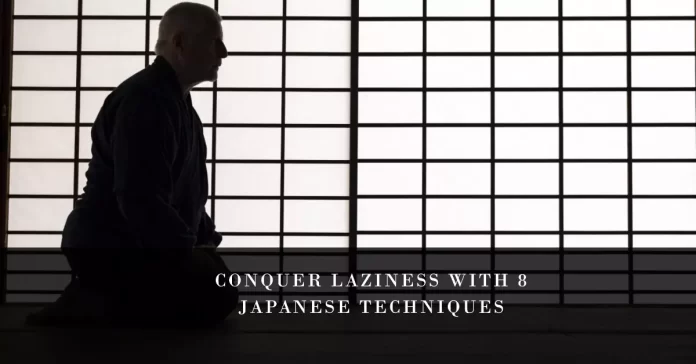Have you ever found yourself procrastinating, stuck in the clutches of laziness? Don’t worry; you’re not alone. We’ve all been through moments when motivation slips away, leaving us stuck in procrastination. The good news is that the Japanese have some powerful techniques that can help you kick laziness to the curb. Let’s dive into these eight methods and discover how they can transform your productivity.
Here are the 8 Powerful Japanese Techniques to Defeat Laziness
Kaizen: Small Steps, Big Changes
The concept of Kaizen centers around continuous improvement through small, manageable steps. Instead of overwhelming yourself with grand plans, concentrate on daily small changes. This approach makes it easier to achieve progress but also reduces the resistance commonly associated with many tasks.Ikigai: Find Your Purpose
Ikigai is the Japanese secret to a fulfilling life. It involves finding the intersection of what you love, what you’re good at, what the world needs, and what you can earn from. A clear sense of purpose becomes a potent motivator, propelling you to overcome laziness and achieve your goals.Pomodoro Technique: Time Management Mastery
This technique involves breaking your work into intervals, typically 25 minutes, separated by short breaks. Maintaining focus and productivity undergo a significant transformation with this tool—it’s a game-changer. By working in short, focused bursts, you’ll find that laziness struggles to keep up.Forest Bathing (Shinrin Yoku): Reconnect with Nature
Japanese culture values the rejuvenating power of nature. Take short breaks to step outside, breathe fresh air, and let the natural environment energize you. It’s a simple yet effective way to combat laziness and boost your general well-being.Kakeibo: Budget Your Time
Just as you budget your money, the Japanese practice of Kakeibo involves budgeting your time. Plan your day with intention, allocating specific time blocks for tasks. This mindful approach helps prevent time-wasting and keeps laziness at bay.Kaikaku: Embrace Change
Kaikaku translates to “radical change” and encourages breaking free from routine. Introduce variety into your tasks to keep things interesting. The novelty will help combat boredom and, consequently, laziness.Hanami: Celebrate Small Wins
The tradition of Hanami, appreciating the transient beauty of cherry blossoms, teaches us to celebrate small victories. Acknowledge and reward yourself for completing tasks, no matter how minor. Positive reinforcement goes a long way in combating laziness.Shoshin: Cultivate a Beginner’s Mindset
Approach tasks with the mindset of a beginner, devoid of preconceptions. Embrace the learning process, and you’ll find that the fear of failure diminishes. Embrace this mindset shift, allowing it to be a powerful antidote to laziness and encouraging you to explore new opportunities.
Conclusion
Impart these Japanese techniques into your routine, one step at a time, and witness the transformation. Overcoming laziness is a journey of consistency and intentionality—embrace these methods, celebrate progress, and embark on a path to heightened productivity. Your future, free from the clutches of procrastination, begins now.
Frequently Asked Questions (FAQs)
How long does it typically take to see results from these Japanese techniques?
Results vary, but the key lies in consistent application. Small changes often lead to significant improvements over time. Be patient, stay committed, and you’ll start noticing positive changes.
Can these techniques be adapted to different lifestyles and schedules?
Absolutely! These techniques are flexible and can adapt to different lifestyles and schedules. Whether you have a busy workday or a more relaxed routine, there’s room to integrate these methods.
Is it necessary to implement all eight techniques, or can I choose specific ones?
Certainly pick and choose the techniques that resonate most with you. While incorporating all eight is ideal for a comprehensive approach, even adopting a few can make a noticeable difference in overcoming laziness.
How do I maintain motivation for consistently using these techniques?
Celebrate small wins, track progress, and don’t forget to remind yourself of the benefits. Motivation often stems from seeing positive changes, so acknowledge your efforts and stay focused on your goals.
Can I integrate these techniques with my existing productivity methods?
Absolutely! Feel free to integrate these techniques with your existing productivity strategies. Experiment to find the best combination that enhances your overall effectiveness.
Are there recommended resources for further exploration of these Japanese techniques?
Yes, several books and online resources delve deeper into each of these techniques. Consider exploring works by Japanese authors or experts in productivity and personal development.
How can I overcome setbacks and stay on track when implementing these techniques?
Any journey naturally includes setbacks. When faced with challenges, reflect on your goals, adjust your approach if needed, and remember that resilience is crucial to long-term success.
Are these techniques culturally specific to Japan, or can anyone benefit from them?
While rooted in Japanese culture, these techniques are universally applicable. The principles of Kaizen, Ikigai, and others are timeless and can work for anyone from any cultural background.










